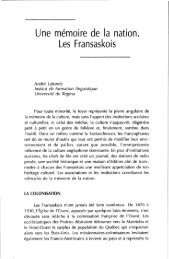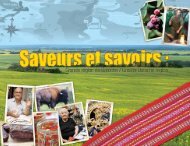Revue Saveurs et savoirs - Partie 2 (.pdf) - Assemblée ...
Revue Saveurs et savoirs - Partie 2 (.pdf) - Assemblée ...
Revue Saveurs et savoirs - Partie 2 (.pdf) - Assemblée ...
Create successful ePaper yourself
Turn your PDF publications into a flip-book with our unique Google optimized e-Paper software.
« Le boudin était le plat consommé le jour de l’abattage<br />
du cochon. Je me rappelle que ma belle-mère, Françoise<br />
LANOVAZ, plaçait ce mélange dans le péritoine,<br />
membrane très fine qui renferme les viscères. »<br />
Ida Périllat<br />
La transformation du porc à la ferme / Pork Processing on the Farm<br />
À la suite de son mariage avec Pierre PÉRILLAT, Ida<br />
PÉRILLAT s’est installée à la ferme de ses beaux-parents<br />
à Duck Lake en 1940. Aujourd’hui, c’est son fils qui s’en<br />
occupe. Ida a toujours eu des animaux sur sa ferme :<br />
vaches, cochons, poules, canards <strong>et</strong> oies. Elle connaît<br />
très bien toutes les rec<strong>et</strong>tes utilisées traditionnellement<br />
sur le territoire pour transformer la viande.<br />
Le cochon notamment se prête à toutes sortes de<br />
transformations : lard salé, fromage de tête, boudin,<br />
viande hachée <strong>et</strong> saucisse. La plupart des familles<br />
réalisaient ce genre de préparation <strong>et</strong> chacun y apportait<br />
sa touche personnelle, en fonction de ses goûts.<br />
Le lard salé<br />
- Faire bouillir de l’eau avec le sel <strong>et</strong> les épices.<br />
- Laisser refroidir c<strong>et</strong>te préparation avant de recouvrir le lard placé<br />
dans un pot de grès.<br />
Le fromage de tête<br />
- Faire cuire la tête <strong>et</strong>/ou les pâtes dans l’eau jusqu’à ce que la<br />
viande se détache.<br />
- Ajouter des épices <strong>et</strong> des oignons à la viande.<br />
- Hacher le mélange <strong>et</strong> ajouter du jus de cuisson de la viande<br />
- Remplir des bocaux avec c<strong>et</strong>te préparation.<br />
Ce mélange forme une sorte de gelée que l’on peut trancher.<br />
Le boudin<br />
- Mélanger le sang frais <strong>et</strong> la crème (3 tasses de sang frais<br />
pour 1 tasse de crème)<br />
- Ajouter le sel, le poivre <strong>et</strong> des oignons hachés finement<br />
- Disposer ce mélange sur une taule à pain <strong>et</strong> cuire au four à<br />
chaleur douce.<br />
“Blood sausage was the dish eaten on the day a pig was<br />
butchered. I remember that my mother-in-law, Françoise<br />
LANOVAZ, would put the mixture into the peritoneum, the<br />
very thin membrane that surrounds the internal organs.”<br />
Following her marriage to Pierre PÉRILLAT,<br />
Ida PÉRILLAT s<strong>et</strong>tled on her in-laws’ farm in<br />
Duck Lake in 1940. Today her son operates it.<br />
Ida always had animals on the farm: a cow, pigs,<br />
chickens, ducks and geese. She is very familiar with<br />
all the recipes traditionally used in the region to<br />
process meat.<br />
In particular, hogs lent themselves to all sorts of<br />
processing m<strong>et</strong>hods: salt pork, headcheese, ground meat<br />
and sausage. Most families carried out these sorts of<br />
preparations and each added their personal touch<br />
according to their tastes.<br />
Salt Pork<br />
- Bring some water to a boil with salt and spices.<br />
- L<strong>et</strong> the mixture cool before covering bacon placed in an<br />
earthenware container.<br />
Headcheese<br />
- Cook the head and/or fe<strong>et</strong> in water until the meat comes<br />
off the bone.<br />
- Add spices and onions to the meat.<br />
- Chop the mixture and add some of the cooking liquid from the meat.<br />
- Pack the mixture into jars.<br />
The mixture forms a kind of aspic that you can slice.<br />
Blood Sausage<br />
- Combine fresh blood and cream (3 cups of fresh blood<br />
to 1 cup cream)<br />
- Add salt, pepper and finely chopped onions<br />
- Place this mixture in a bread pan and cook in the oven<br />
at low heat.<br />
57




